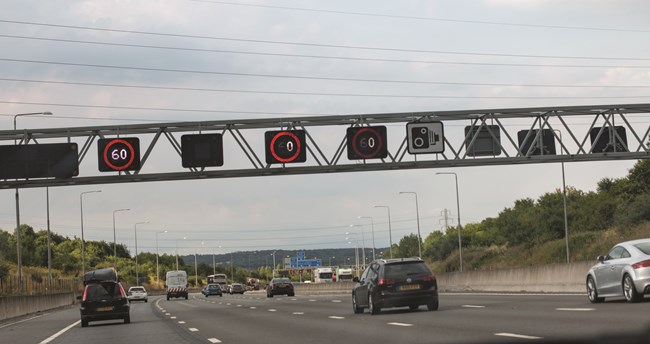
The start point for the best source of fleet information |
Smart motorways review suggests detail improvements
Date: 27 March 2020 | Author: Illya Verpraet

The Department for Transport (DfT) has concluded its investigation into the safety of controversial smart motorways. Edmund King, president of the AA, said: "We applaud the current Transport Secretary, Grant Shapps MP, for instigating the review and taking this issue very seriously."
In its report, DfT found that smart motorways are just as safe as normal motorways, with the exception of an increase in accidents involving cars stopped in a live lane. To address this problem, it plans to increase the number of emergency refuge areas and upgrade the equipment that automatically detects a stopped vehicle.
A smart motorway is a section of motorway that uses overhead matrix signs to control which lanes are open and what the speed limit is. There are three types of smart motorways: controlled motorways, which simply have the digital signs, but retain a permanent hard shoulder; those with a dynamic hard shoulder (DHS) - where there is a hard shoulder, but it can be used as a live lane if necessary; and finally, so-called 'all-lane running' (ALR) motorways, where there is no hard shoulder at all.
DfT found that "a lower share of fatalities occurs on DHS and ALR compared to the motorway network as whole". Only in 2017 was the rate of fatalities higher on the motorways with no hard shoulder. However, non-fatal casualties have always tended to be higher on smart motorways than on the motorway network as a whole.
As is to be expected on a motorway with no hard shoulder, the report found that the number of breakdowns in a live lane is significantly higher than on a conventional motorway - 40% of breakdowns on ALR motorways happened in live lanes, compared with 27% for DHS sections and 20% on conventional motorways.
As a result, the number of collisions per year involving a vehicle stopped in a live lane increased from three before the motorway was converted to 19 after. Serious collisions rose from an average of 0.3 per year to seven, while fatal collisions rose from none to 2.8.
As a result, DfT's plans focus mainly on increasing the number of emergency refuge areas and improving the detection of stopped vehicles.
The report states: "Going forward, we will commit to a maximum spacing of one mile apart and look to, where feasible, provide them every three-quarters of a mile apart". This is already the design standard for newly converted sections.
King said: "The original M42 managed motorway pilot in 2006 with emergency refuge areas (ERAs) every 500m worked well, but after that the goalposts were moved and the roll-out began with ERAs at every 2,500m (1.5 miles). We believe the intention to place ERAs at every three-quarters of a mile is a great outcome and [it's] what we have called for over the last decade."
DfT will also retrofit 10 additional emergency areas on high-risk sections of the M25 and consider modifying existing smart motorways in the same way if the changes on the M25 prove successful.
To reduce the likelihood of a collision with a stopped vehicle, Highways England has also trialled and implemented a separate radar-based stopped vehicle detection (SVD) system, and will roll it out on all smart motorways in the next 36 months.
This system is designed to detect a stopped vehicle in less than 20 seconds and allow an operator to close a lane more quickly. To support this, and to ensure drivers comply with lane closures, those who ignore a red X on the overhead sign will be automatically detected, fined £100, and will get three points on their licence.
RAC head of roads policy Lyes commented: "On the basis [that] ALR smart motorways remain the default, the commitment to install stopped vehicle detection technology on the whole network is a positive step, but a three-year timeframe will feel like an eternity considering the concerns many drivers have about ALR schemes."
To ensure stranded vehicles are recovered quicker, DfT will increase the number of traffic officer patrols on smart motorways, aiming to reduce the average attendance time from 17 to 10 minutes.
Finally, DfT will improve communication with drivers by painting the emergency areas bright orange, installing additional signs, spending £5 million on national and targeted communications campaigns, and converting DHS sections into ALR motorways by March 2025 to avoid confusion.
Joshua Harris, director of campaigns for road safety charity Brake, commented: "Safety must always be the priority when it comes to our roads and so we cautiously welcome today's announcement on smart motorways. The new measures will go some way to addressing the safety concerns of those using smart motorways and should be implemented as a matter of urgency."










